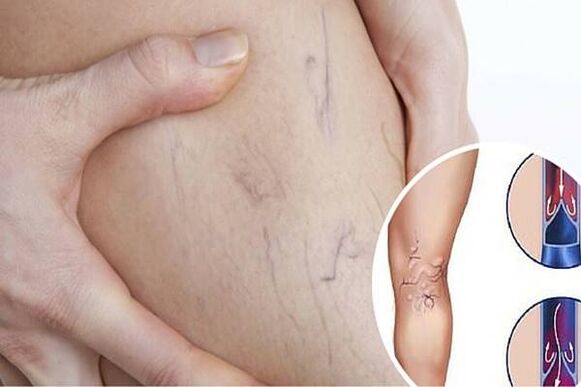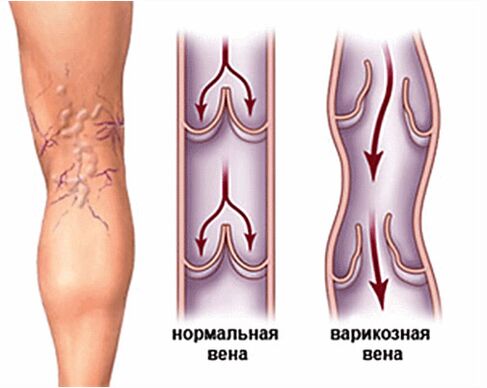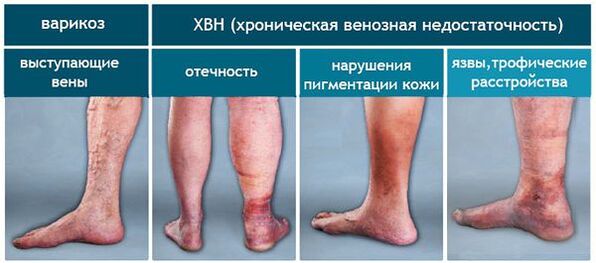According to statistics, about 83% of the population faces a disease like varicose veins of the sub-extremities.Therefore, it is important to know how the veins of varicose veins in the early stages look.This will determine the disease in a timely manner and prevent the development of possible complications.

Varicose types of veins
Destruction of the disease of the vessels, which accompany the expansion, can affect various bodies of the body.Therefore, the classification of this pathology is based on the location of localization.
According to the international classification of 10th diseases, the types of such diseases are different:
- Varicosis of the blood turnover system.
- Expansion of the vessels of the digestive system.
- Accumulation of numerous pathological clots in one place.
- In other parts, non-systematized lymph nodes and vulgarity of ships.
- Varicosis of lower extremities.
In medical practice, the use of ICD 10 allows a flebologist to differentiate the necessary diagnosis and varicose veins.
In turn, varicose veins in low extremities are classified to disease depending on the course stage:
- Ulcerative lesions.
- Progressive inflammatory processes.
- Ulcer and inflammation.
- Varicosis of the legs or other parts damage the skin of the skin.
- The lack of deformation of the veins in the inflammatory processes.
Varicosis vessels differ in the main areas of the localization of pathological changes:
- Surface veins.
- Deep veins.
- Rica.
The wide classification of varicose veins is determined by various options for the course of the disease.In the difference between the pathology, modern doctors use not only ICD-10, but also the forms of the disease.
In medical practice, such forms of varicose veins are different:
- Partial damage to the blood vessels of non-reverse-flowing subcutants and intradermal type.
- Segmental defeat with bloodshed along all veins.
- Extensive defeat with the discharge of pathological etiology in subcutaneous veins.
- A common lesion of a veins containing an abnormal discharge through deep veins.
Deformation of the vein and the dysfunction of the blood flow can be several types.Only one doctor can determine a type of dimensional diagnosis and varicose expansion based on the results of complex examination.

The degree of varicose veins
Depending on the process of progression of the disease, varicose veins have 4 stages of development.Each of them is characterized by a particular symptoms.
- In the first stage, the legs and pain of a painful nature feels the violence.Vascular stars, knotted veins and swelling images.The mandatory spasms of the calf are possible in the control of the burning area and the leg region.Characterized by lack of stagnation in the bloodstream.
- The second rate of varicose veins is accompanied by oxygen hunger of the venous system.It is characterized by a speedy increase in the size and number of vascular junctions and stars.Such damage, clearly stated the boundaries that contribute to their brighter manifestations.Perhaps the grouping in the same area of defeat is small behind the area.In this case, the pain and swelling of soft tissues was reinforced.
- With the third rate of varicose veins, the trophic lesions of the medial surface of the lower leg are formed.With the advancement of the disease, it is characterized by the appearance of brown areas covered with dry crust and crack.Dermatitis is possible in their background.Having a great edema is dangerous.There are many fatigue and pain.
- The fourth degree is the aggravation of the disease.In the walls of the veins, inflammatory processes may appear in the form of trophical ulcers.Bleeding seals are possible by mechanical damage.This degree is dangerous to develop venous shortages that can obtain a chronic form later.
In the third and fourth stage, the patient begins to experience a difficult pain in both muscles and venous trunks.It is quite rare, the chapter may be the rupture of nodes accompanied by a blood loss.Most, such a sign showed itself in the night.If varicose veins, hyperthermia and growing weakness reveals, it shows the formation of complications of the disease.
Varopoly itself is not a dangerous disease that is not unanswered to therapy.However, it should be noted that the pathology did not go to its own and progress quickly.Determining the vascular vascular vascular vascers increases the conditions of rapid and successful recovery.The fourth degree starting varicose veins are dangerous for the body and human life.

Stages of varicose veins of the sub-extremities
Varicosis is characterized by several stages of pathology.Each one determines the spread of the disease and has certain features.Each has many classifications of varicose veins of varicose veins with their symptoms and therapy.In most professional practice, modern doctors use the classification of varicose veins for the degree of blood flow in the vessels of the body.
The following stages of the disease are different:
- Characterized by the presence of cosmetic manifestations.There are no signs of thrombosis, but when examining the patient, the initial stage of the vascular vascular vascular veins is found.Depending on the etiology of the pathology, the compensation phase of varicose veins without the relevant treatment can be transformed into secondary varicose veins.
- Blood vessels are exposed to deformation and clearly reflect the surface of the feet.The heedosis of this stage is accompanied by pain and swelling of lower extremities.There is a sense of violence, the feeling of explosion and increases skin sensitivity.Swelling in the legs strengthens in the evening and disappears the next morning.
- The visual signs of pathologists are significantly increasing.Venous net and junctions are not in the field, but also in volume.Itching seems an intensive sensation.The skin surface takes a shade of darkness, dry and bright.At this stage, a small bleeding leads to collapse that causes the skin's hyperpigmentation in the affected areas, which causes the collapse of hemosideers.
The initial stage of varicose veins for each organism continues differently.The intensity of the symptoms manifestation and the term of this period depends on individual and many factors.Therefore, in the manifestation of the smallest features of pathology, you should immediately seek qualified medical services.Time treatment will prevent the development of more serious stages of varicose veins.
The initial stage of varicose veins in the legs: treatment of pathology
The effectiveness of the therapeutic course with varicose veins depends on the timely manifestation of the pathology.In the early phase of the development of the disease, qualified medical care allows the integrity of the vascular wall and the functionality of damaged vessels.
The treatment of varicose veins of the initial stage is being treated thoroughly and consists of:
- Complex use of drugs.For complex effects on the veins, the tablet preparations are made by mouth.The use of local medicines and gel in the form of a gel has a high therapeutic effect.
- Sclerotherapy.Mandatory dress of a special compression knitting after the procedure.The efficiency of sclerotherapy explains the use of a compensation phase for varicose veins of the lower extremities.
- Ozonotherapy.At the initial stage, varicose relates to the treatment of varicose vessels as one of the components of the components of the components of the comprehensive therapy.Such procedures increase the nutrition of cells with oxygen and stimulate blood circulation through the veins.As a result, stick the affected walls of blood vessels.
Each of the methods of therapy for varicose veins requires mandatory medical recipes and controls.The self-determination of varicose veins is strictly prohibited.
In the lower extremities of the initial degree, varicose veins are difficult to diagnose an independent diagnosis.Visual information on the Internet contributes to visual acquaintance with characteristic signs of pathology.


















